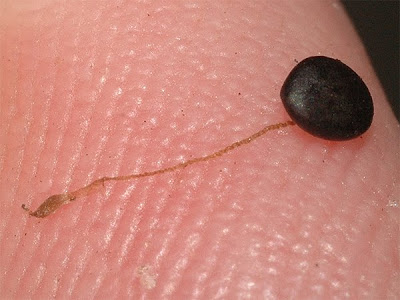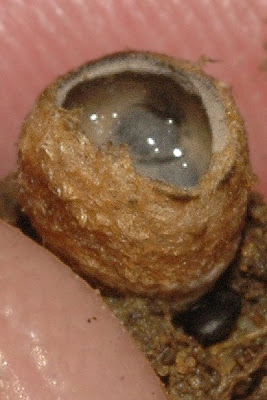I went back to Lucy's front lawn and collected a few specimens, to try to answer this and another question which was unresolved (in my mind) from yesterday.
Firstly, to the stringy attachment. It is true. Here are several photos. What I did was take a fine metal spike to lift out a single peridiole from one of the Birds Nests. I failed, as I got two - which were stuck together.
 What you can see is the slightly zig-zagged string stretched out, from a very sticky "bag" (top left of image) which was indeed stuck to my finger. The second peridiole (top one) has a thick mass of "glue-like material" still all bunched up underneath the shell. It is stuck to the stretched out string of the first peridiole.
What you can see is the slightly zig-zagged string stretched out, from a very sticky "bag" (top left of image) which was indeed stuck to my finger. The second peridiole (top one) has a thick mass of "glue-like material" still all bunched up underneath the shell. It is stuck to the stretched out string of the first peridiole.I tried again, to get a single "periodole" for close examination. Here it is on my index finger.
 Here it is in close-up. You can clearly see the "bag" of sticky material on the end of the string. And the string itself is very tightly "folded". No doubt, under ideal circumstances, it could have stretched out further than it did. As it is, it only stretched to about 1 cm. Certainly the sticky patch worked, to attach the peridiole to my finger.
Here it is in close-up. You can clearly see the "bag" of sticky material on the end of the string. And the string itself is very tightly "folded". No doubt, under ideal circumstances, it could have stretched out further than it did. As it is, it only stretched to about 1 cm. Certainly the sticky patch worked, to attach the peridiole to my finger. If you have looked at the essay from the ANBG website, posted by Heino Lepp, from the Centre for Plant Biodiversity Research, you will recognise this structure from the sketches on that page.
If you have looked at the essay from the ANBG website, posted by Heino Lepp, from the Centre for Plant Biodiversity Research, you will recognise this structure from the sketches on that page.The second puzzle which was still troubling me, was that I said yesterday that I did not see any of the birds nest fungi which were closed. It seemed improbable that all the Birds Nest Fungi would be of the same age and stage of maturity. So, I did try today, to collect one which was "intact". Well I found one which had a membrane. While it was only partly closed. The edges of the vase-shaped structure were relatively narrow - not at all the open reflexed structure visible in the more advanced (mature) structures we saw in yesterday's post.
I was puzzled by one aspect of Gaye's post (which I linked to yesterday). It seemed from one of her photographs that the "cap" which is referred to in the literature was a "cap" which might fall off, in much the same way as a "gumnut" falls off a Eucalypt flower, as it opens (think of the "Gumnut Babies hats"). Upon closer examination of Gaye's image today, I realised that my idea was caused by an optical illusion. What appeared to me (initially) as a separate cap falling off, was nothing of the sort. I was seeing the edge of another 'Birds Nest Fungus", behind the main capsule I was looking at. Silly me.
In the right of this image posted by Gaye, you can clearly see the "membrane" cracking. I would definitely refer to it as a "membrane" rather than a "cap".
In the example I saw this morning, it was not even as clearly a triangulated split as in Gaye's photo. Rather the sides of the capsule appeared to be "flatter" (with two sides close together) than when the capsule opens out fully (when it is rounded). Here you can see the same "fresh" capsule, after I managed to bring the specimen home. By that time, the cup had fully opened, and the membrane had more or less disappeared. It has probably shrivelled up, as happens with the membranes underneath many "capped Mushrooms" as they mature.
 What is interesting to note, however, is how "soupy" the fresh material inside the capsule looks. I shall examine it tomorrow, to see how it might have changed, as it matures.
What is interesting to note, however, is how "soupy" the fresh material inside the capsule looks. I shall examine it tomorrow, to see how it might have changed, as it matures.

No comments:
Post a Comment